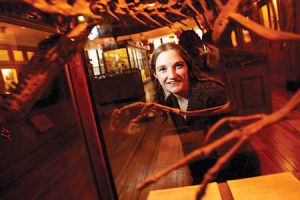
By Neale McDevitt
Emily Bamforth has a bone to pick, and it happens to be hundreds of millions of years old. “People see dinosaurs as nothing more than big monsters,” says the PhD candidate in paleooecology and paleobiodiversity.
“In fact they were animals like the ones we have today, that had complex biological and ecological interactions with the world around them.”
On Jan. 20, Bamforth will clarify some of the more popular misconceptions about dinosaurs during her lecture “The Misunderstanding of Dinosaurs.” The event is part of the Redpath Museum’s ongoing Freaky Friday series.
People are also guilty of mislabeling all animals of that era as dinosaurs. “Flying reptiles – pterosaurs – lived during the same time but they aren’t related to dinosaurs,” says Bamforth, “and neither are marine animals – like Ichthyosaurs and the ever-popular sail-backed Dimetrodon. It’s another myth that has been perpetuated in popular science: dinosaurs on land, flying dinosaurs in the air, swimming dinosaurs in the water. But it isn’t true.”
Bamforth, who knew she wanted to be a paleontologist after seeing her first dinosaur skeleton in a museum in Cardiff, Wales, does most of her fieldwork in southeastern Saskatchewan, in the badlands of Grasslands National Park and the Frenchman River Valley. There, she scours vertebrate microsites – where she hopes that the high accumulation of small fossils and bone fragments will give her insight into the changes in biodiversity over a period of about 600 million years right up to the dinosaur mass extinction.
The Misunderstanding of Dinosaurs; Friday, Jan. 20; Redpath Museum Auditorium; 5 p.m. Admission is free. For more info go to www.mcgill.ca/redpath/whatson/freakyfridays
